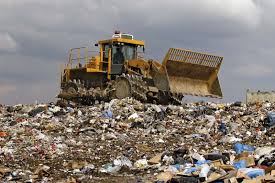Not only are there multiple sources of waste, but there are multiple types of wastes. It is important to understand the characteristics of each type of waste in order to select and apply the most appropriate management and disposal method.
1. Solid Waste
Solid waste, commonly referred to as “garbage” or “trash”, consists of discarded materials and items.
There are many options available for managing solid waste including recycling, composting, landfills, and incineration. In selecting the most appropriate waste management technique, the items’ component materials must be considered in addition to budget and waste management goals.
Proper solid waste management in landfills is extremely important as the accumulation of materials has the potential to lead to issues with odour, chemical exposure, environmental contamination, and the spread of disease.
2. Liquid Waste
Liquid waste, also referred to as wastewater, is produced in the residential, commercial, and manufacturing sectors. The source of wastewater will impact its composition and therefore treatment requirements.
In some cases, liquid waste may contain chemical compounds which are hazardous to human health and the environment and in these cases, wastewater would require more stringent processing and treatment. Oils must be properly disposed of through a separate process.
Inadequately or improperly treated wastewater released into lakes, ponds, steams, rivers, or aquiferscan have significant health and environmental impacts, including (Government of Ontario, 2014):
Excessive nutrient run-off (most commonly nitrogen and phosphorus) causing eutrophication, a process characterized by excessive plant growth and die-off reducing the available oxygen in an ecosystem which in turn degrades spawning grounds and harms aquatic wildlife;
Increase in volume of chlorine compounds which are toxic to aquatic life;
Read Also : Introduction to Waste Management and Sources of Waste
Contamination of drinking water by bacteria and disease-causing pathogens such as E.coli; and
Release of micro-plastics and fibres into waterways which bio-accumulate in wildlife.
3. Gaseous Waste
Gaseous waste has many anthropogenicsources including manufacturing, processing, and the consumption of goods, as well as biological processes such as the decomposition of organic material.
A significant portion of gaseous waste is also produced through burning fuels, exhaust from motor vehicles and power plants, as well as the production of fertilizers and pesticides used in agriculture (Woods et al., 2010).
Common pollutants found in gaseous waste include; carbon monoxide (CO), sulfur dioxide (SO2), nitrogen dioxide (NO2), methane (CH4), and particulate matter, defined as small particles of gas, dust, and other matter.
Read Also : Hurts Wastewater Management Complete Guide
If released, untreated gaseous waste can lower air quality and increase ambientairpollution. Technologies to capture and prevent gaseous waste from being released into the environment, such as scrubbers and filters, are commonly used to manage pollution levels.
These pollutants are not just harmful to human health, but they can also be potent greenhousegases(GHGs) such as methane, which are significant contributors to climate change.
In Canada, it is estimated that landfills are responsible for up to 20% of methane emissions (Natural Resources Canada, 2017).
While it would be preferable to divert organic materials from landfills, it is possible to both capture and repurpose gaseous waste from landfills to generate electricity, fuel industries, heat buildings, and reduce dependency on non-renewable energy sources.

